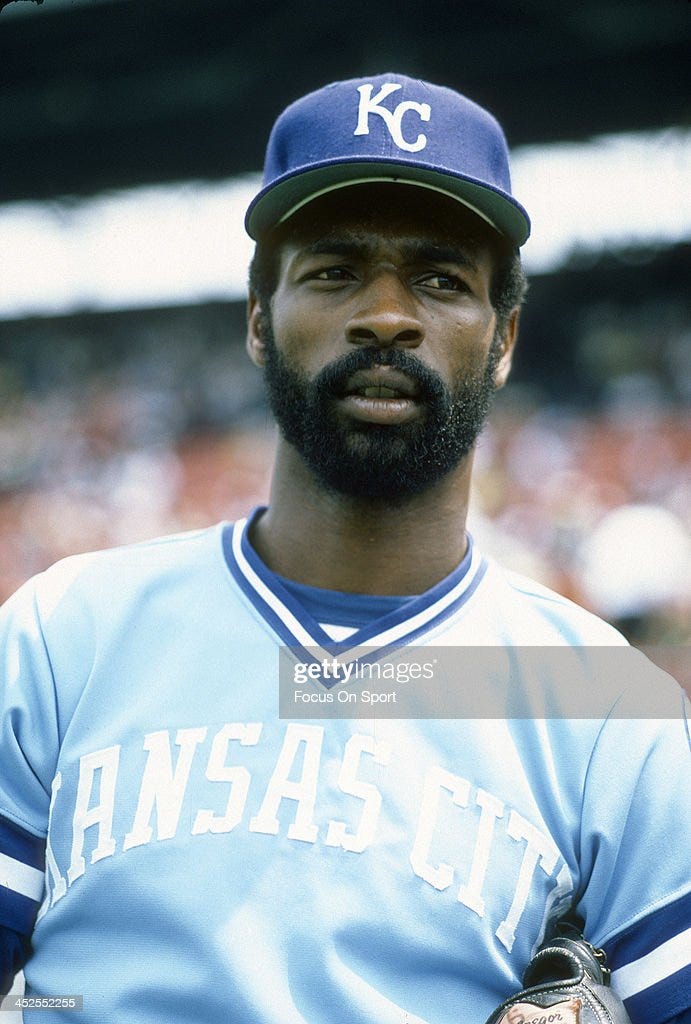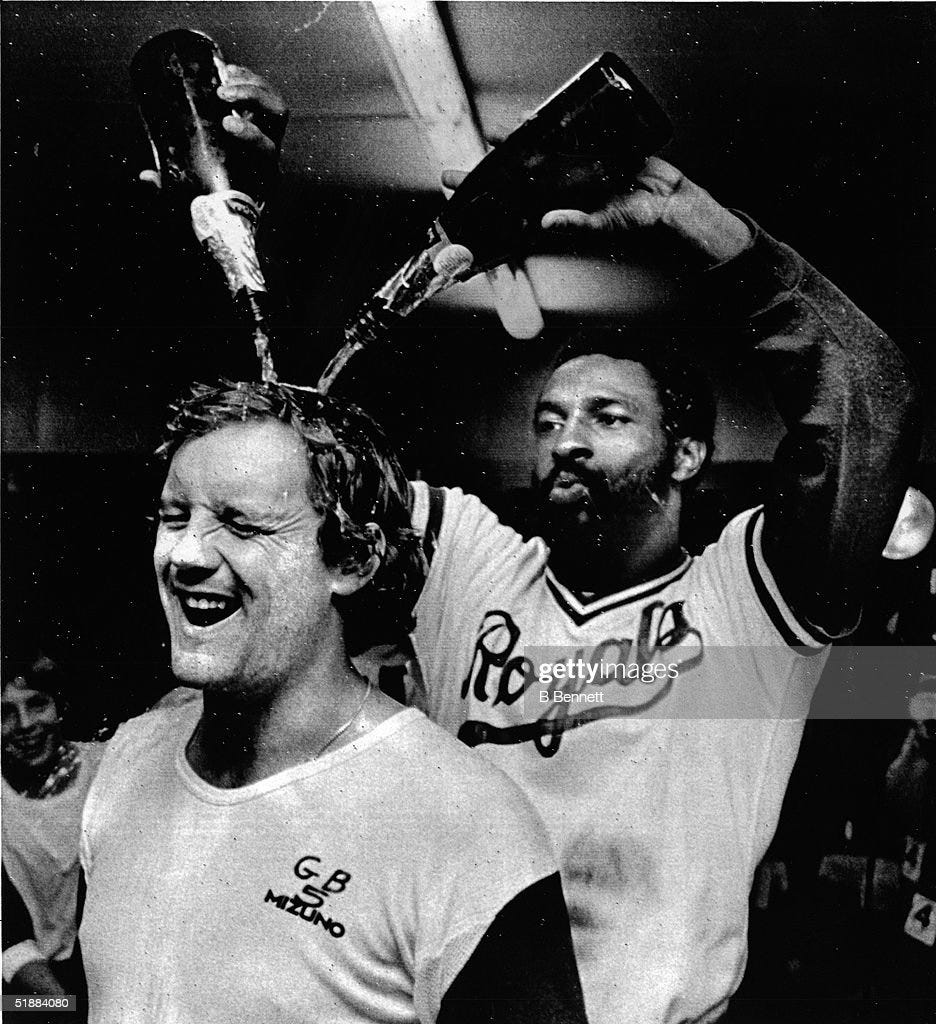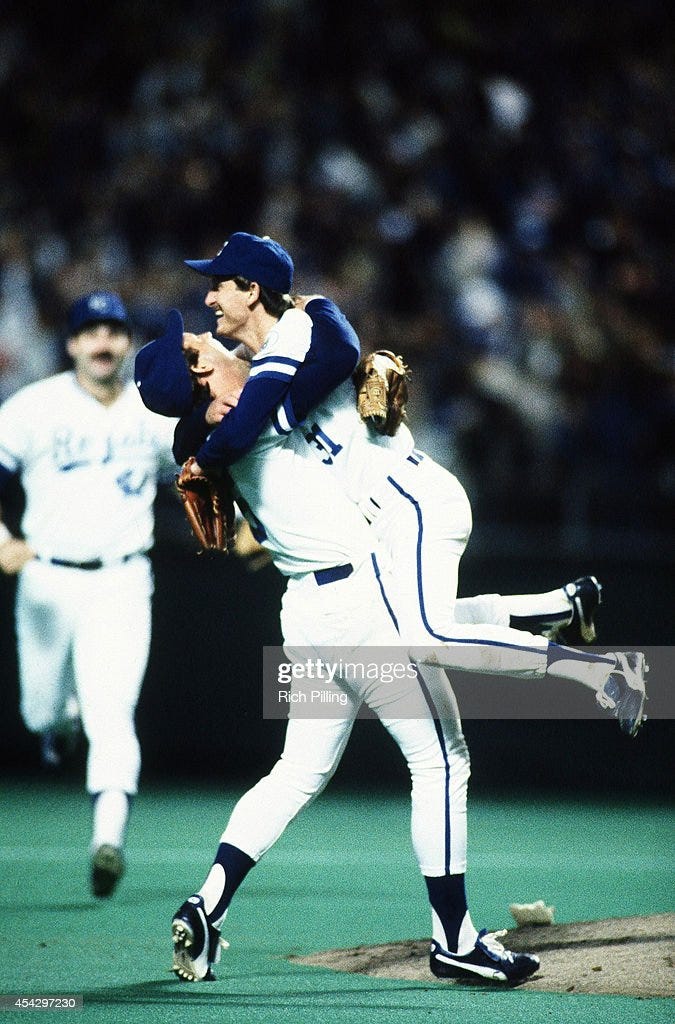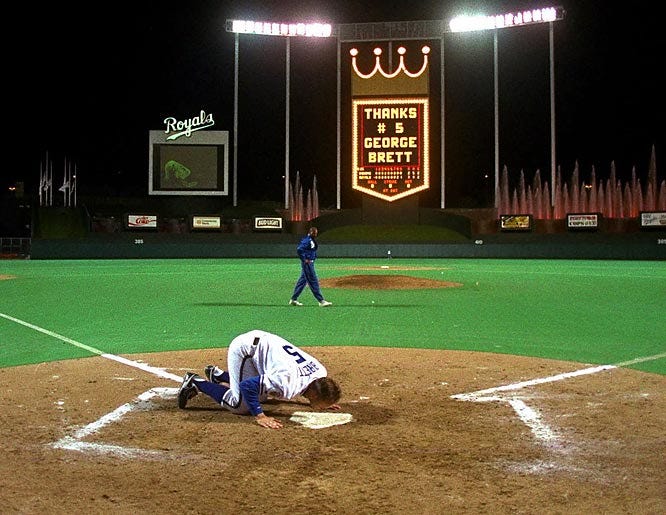There is a sprawling estate just north of Platte City (which is, itself, north of Kansas City) surrounded by an old-fashioned white wooden fence. Horses frolic in the pasture, and a mildly curvy lane leads up the hill to a secluded and stylish house that one could call a mansion. It’s the kind of home where someone really important should live.
Not surprisingly, when we were young and riding home from our summer treks to Royals Stadium, my cousin Scott and I decided that must be where George Brett lived.
Never mind that we had no evidence whatsoever to base this conclusion on. It seemed more than reasonable at the time, and we both still jokingly refer to it as George’s house to this day. I have no idea who lived in it back then or who lives in it now, and that’s not the point.
The point is that the house felt like it was built for a king, or a hero, or a legend, and George Brett was nothing in Kansas City, if not all those things. No athlete has ever owned the city the way he did, at least until Patrick Mahomes came along, and even then, I suspect it’s a closer call than people think.
Football was definitely rising in popularity in the eighties, but it wasn’t yet the end-all, be-all it is today. Kansas City was a solid baseball town back then, the Royals were consistently good every year, and George Brett was the shit.
I can’t think of a better way to put it, and no, that’s not a reference to his well-publicized ass. But if you’ve never watched the video of him talking about shitting his pants, take a minute and do so. It might be the weirdest conversation you’ll ever hear from a sports legend— okay, that’s probably a gross overstatement, the key word being gross. And it’s especially disconcerting to hear from your boyhood idol.
Then there’s his hemorrhoid problem in the 1980 World Series. He left in the sixth inning of Game 2 with extreme hemorrhoid pain, had surgery to remove them the next day, and then came back to homer in the first inning of Game 3.
In fact, one of the greatest hitters who ever lived was known primarily as the hemorrhoid guy for several years, until he became even more famous for losing his mind during the Pine Tar Incident.
Entire books have been written about the Pine Tar Incident, and like the 1980 World Series, it’s before my time, so I’m not going to rehash it here. Besides, there’s a lot more stuff to talk about when it comes to George Brett.
First, let’s start with some of the basics.
He was a thirteen-time All-Star at 3B from 1976-1988, AL MVP (1980), three-time AL Batting Champion (1976, 1980, and 1990, the only player to ever do it in three different decades), World Series Champion (1985), ALCS MVP (1985), 3,000 Hit Club, and first ballot Hall of Famer.
In 1980, he came closer to hitting .400 than anyone since Ted Williams last achieved the feat by hitting .406 in 1941. Brett hit .390, falling five hits short of .400. (Tony Gwynn hit .394 in 1994, which is worth talking about on its own, but that was a strike shortened season, so we’ll give the edge to Brett here.)
Brett’s 1980 statline: .390/.454/.664, 24 HR, 118 RBI, 33 Doubles, 9 Triples, 1.118 OPS, 203 OPS+.
And here’s his line from the 1985 championship season: .335/.436/.585, 30 HR, 112 RBI, 38 Doubles, 5 Triples, 1.022 OPS, 179 OPS+.
After dealing with injuries and some growing pains early in his career, almost every year of his career reads like that. It’s ridiculous. But he wasn’t just some guy putting up insane stats like Mike Trout does now. Brett was clutch, and he had a flair for the dramatic.
The 1977 Royals still have the best regular season record in franchise history, but they lost to their hated rivals, the Yankees, in five games in the ALCS. Can you imagine the Royals and Yankees as the most heated rivalry in baseball? That’s how good the Royals were back then.
Brett hit .300 in that series, but the defining moment of that series is probably Brett punching Yankees 3B Graig Nettles after Nettles kicked him in the face while Brett was sliding into third. Brett didn’t back down from anyone.
A year later, the Royals lost to the Yankees again in the ALCS, this time in four games. This was through no fault of Brett, however. He homered three times off of Catfish Hunter in Game 3, but the Royals still lost the game, 6-5.
In 1980, he personally got the Royals over the hump, winning Game 3 of the ALCS with a go-ahead moon shot into the upper deck of Yankees Stadium off of Goose Gossage in the top of the seventh, completing the sweep of the Yankees. Royals fans of a certain age still remember where they were when he hit that home run.
I’m not one of them. I was one year old at the time. But Brett still had more in the tank. I’ve talked about him homering in my first game, but later that same year, Brett had arguably the greatest game of his career when the Royals needed it the most.
Down 2-0 to Toronto in the 1985 ALCS, the Royals went on the road and Brett showed out in what it often simply referred to as “the George Brett game.” Before the game, he told his teammates to “climb on my back.”
He then went 4-4 with 2 HR and a double that bounced off the top of the wall (so close to 3 HR!), scoring four runs and knocking in 3 RBIs. His second HR tied the game at 5 in the 6th inning, and he singled in the game winner in the 8th. He also made one of the greatest defensive plays of his career in the 3rd, snagging a hot shot from Lloyd Moseby down the third base line and saving a run with a jump throw to gun down a runner at home.
Brett could definitely flash the leather. He may be remembered more as a hitter, but I vividly recall him sliding into the dugout in an attempt to catch a foul ball with reckless abandon during Game 5 of the 1985 World Series.
The Royals rallied from being down 3 games to 1 in both the ALCS and World Series in 1985, and the culmination of that journey is best summed up in the image of Brett joyfully bear-hugging Bret Saberhagen after the last out of the World Series.
Man, I loved George Brett. I think it was pretty much mandated that he had to be your favorite player if you grew up rooting for the Royals in the eighties, but it was more than that to me.
I wore a sleeveless gray t-shirt with his name and number on it. It had this weird raised lettering on it that was tacky to the touch, but I thought it was cool. I wanted to play 3B in little league like he did, even after he eventually moved to 1B and DH. And yes, I wanted to live in “his house.”
I watched his gradual decline, in which he still performed better than most MLB players. He won a third batting title in 1990, chalked up his 3,000th hit in 1992, and memorably kissed home plate after his final game at Royals Stadium in 1993.
In the years since, he’s remained a Kansas City legend, and there are more good Brett stories out there than I can recount here. He was even in an episode of Brockmire— how can you not like him?
But he wasn’t the only great player on those Royals teams, and while I still revere him as a player, I’m not sure that he’s still my favorite all-time Royal. No, I haven’t replaced him with a more recent Royals star like Salvador Perez or Alex Gordon. Nothing like that. In fact, his place on top of the mantle might have been stolen by my second favorite player back in the eighties— Willie Wilson.
Somehow, that seems right. Stealing was something that Willie Wilson was really good at. Thanks to his blazing speed, he stole 668 bases during his career. He also hit 281 Doubles, 147 Triples, and 13 inside-the-park HR, by far the most of any player since the deadball era.
One of those inside-the-park home runs came on the day I was born, June 9, 1979. He walked off the Yankees in the bottom of the 13th, winning the game 9-8. Then he stole two bases and scored three runs in my very first game in 1985. No wonder I’ve always felt a special connection to him.
Wilson was the total package. I recently read an article on Royals Review that argued he would probably be playing football if he were coming of age today, and I can’t argue with that. He was nearly a football player anyway. I’m just glad he came along when he did.
He is one of the great centerfielders in Royals history, and they’ve had some phenomenal ones like Amos Otis and Lorenzo Cain. Otis’s game was built on efficiency, and LoCain was deceptively fast. He always looked like he had a pulled groin when he was walking normally, and then he would turn on the jets. Wilson, on the other hand, was silky smooth in everything he did.
If he were playing baseball today, I suspect they would have ruined him, pressuring him to bulk up and hit for more power at the expense of his speed. He still would have been fast, but with stolen bases out of fashion, triples on the downturn, and inside-the-park home runs incredibly rare, he just wouldn’t have been the same weapon. And that would have been a shame, because he was so much fun to watch.
Wilson was more than just blazing speed, though Bill James once argued that he might have been the fastest man to ever play professional baseball. Dwight Evans said he’d “never seen anything like him turning second” on a base hit to left. As his stats attest, he wasn’t just fast— he was a smart base runner.
And they tell more than that. The man could hit as well. Maybe not like Brett, but he won an AL Batting Title of his own in 1982, and he had the most 3+ hit games in the eighties in MLB.
This was a guy who led off a lineup that regularly included Brett, Frank White, Hal McRae, Darrell Porter, Steve Balboni, and others. His job was to get on base, get into scoring position, and set the table, but he could swing the wood as well as any of them.
And here are his stats for 1982, the year he won the batting title: .332/.365/.431 3 HR, 46 RBI, 230 H, 133 R, 19 Doubles, 15 Triples, 37 SB, .796 OPS, 118 OPS+.
Sure, there was some of the nonsense frequently surrounding batting titles on the last day of the regular season. Royals manager Dick Howser convinced him not to play in a meaningless game, then conspired with A’s manager Billy Martin to extend the contest until Milwaukee’s game wrapped up and they knew where Robin Yount’s average stood and whether or not they needed to give Wilson an at-bat.
Yount failed to catch him, and Wilson stayed on the bench. So maybe he backed into the batting crown, but considering he led the league in at-bats that season, perhaps that is going a bit far. However you look at it, Wilson was more than deserving.
Nor was Wilson simply an offensive force. His first minor league manager described having Wilson in CF as like having four outfielders. This reputation continued into his major league career, and he won a Gold Glove in 1980 and compiled a highlight reel of dazzling defensive plays over the years.
Even late in his Royals career, as his bat began to fall off, he remained an outstanding defender, leading the league in fielding percentage for CFs in 1989 and all outfielders in 1990. After signing with the A’s in 1991 as a fourth outfielder, he took over everyday CF duties after an injury to Dave Henderson and helped Oakland win the AL West in 1992.
He also stole seven bases in the 1992 ALCS for Oakland, so he could still motor. Unfortunately, he’d trimmed the truly magnificent beard he’d sported during his Royals prime by then. Oh well, nothing lasts forever.

None of this explains why Wilson has passed Brett as my all-time favorite Royal though. And the truth is, I don’t have a good answer. I have some ideas, but nothing concrete.
I don’t see a whole lot of myself in Wilson. Not that I see a whole lot of Brett when I look in the mirror either, but there is one thing we have in common, which often plays a significant role in who we identify with, whether we want it to or not.
Wilson is a black man from a previous generation. He grew up without a dad in New Jersey, raised by his grandma and extended family. He was lightning fast. I am decidedly slower. My beard is just okay.
Perhaps his failings have endeared me to him as much as his many successes. After winning the 1980 ALCS MVP, Wilson was dreadful in their six game World Series loss to the Phillies. He hit just .154 and struck out twelve times, including the last out of Game 6.
Then he bounced back in the 1985 postseason, hitting .310 in the ALCS and .367 in the World Series, earning his first and only ring.
In November 1983, he was busted for cocaine possession and became the first active MLB player (along with three teammates) to serve time in a federal penitentiary that offseason. After initially being suspended for all of 1984, his suspension was reduced after appeal and he successfully restarted his career.
I have firsthand knowledge of the damage caused by drug abuse, and as such I have a certain level of empathy for professional athletes who struggle with addiction. I always root for them to come back, and the ones that succeed have a special place in my heart. Wilson is definitely one of them.
But maybe I’m overthinking the subject. It could be that Wilson edged ahead of Brett the first time my little league coach penciled me in at CF. Catching fly balls was the most exhilarating thing I ever did in my short and unimpressive athletic career. Perhaps it forged a bond with Wilson I never experienced with Brett during my mediocre tenure on the hot corner.
Or maybe it’s as simple as Willie was just always faster than George. He was bound to lap him eventually.
Thank you for reading Powder Blue Nostalgia. Let me know your favorite player below in the comments. And if you liked what you read, please share us with others.







Your last sentence always makes me chuckle.
Great story Patrick! 👏